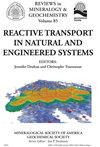Synthesis, Structure, and Properties of Monazite, Pretulite, and Xenotime
1区 地球科学
Q1 Earth and Planetary Sciences
引用次数: 208
Abstract
### General characteristics Orthophosphate compounds of the type A(PO4) include the minerals monazite [RE(PO4) with RE = the light rare-earth ions, e.g., La, Ce, Nd…], xenotime [Y(PO4), and also incorporating the heavy RE ions], and pretulite [Sc(PO4)]. The name of the mineral monazite is derived from the Greek word monazein , “to be solitary,” whereas that of xenotime is derived from the Greek words xenos , meaning “foreign” and time , meaning “honor.” The mineral pretulite is named for Pretul Mountain, located in the Fischbacher Alps in Styria, Austria where the mineral was discovered (Bernhard et al. 1998). Pretulite is only the sixth mineral to have been found in which scandium is a major constituent. The anhydrous rare-earth (RE) orthophosphates can be structurally divided between the light RE-element compounds with the monoclinic monazite structure (space group P 21/ n , Z = 4) and the heavier RE compounds with the tetragonal (zircon-type) xenotime structure (space group I 41/ amd , Z = 4). In terms of the crystal chemistry of these two groups of compounds, a primary distinguishing structural feature is the coordination of the RE, Y, or Sc ions. In the monoclinic monazite structure, the RE ion is located in a polyhedron in which it is coordinated with nine oxygen ions. In the tetragonal xenotime structure, the heavier REs, Y, or Sc are located in a polyhedron in which they are coordinated with eight oxygen ions. Scandium orthophosphate is the basic constituent of the recently identified mineral, pretulite, which belongs to the orthophosphate group with the tetragonal xenotime structure (Bernhard et al. 1998). Both monazite and xenotime are relatively widely distributed as microcrystalline (or small crystalline) accessory inclusions in granitic rocks, rhyolites, pegmatites, and gneisses. Monazite also occurs in carbonatites, charnockites, migmatites, and …Monazite, Pretulite和Xenotime的合成,结构和性质
A型(PO4)硫磷化合物的一般特征包括矿物独居石[RE(PO4), RE =轻稀土离子,如La、Ce、Nd等],xenotime [Y(PO4),也含有重稀土离子],以及pretulite [Sc(PO4)]。矿物monazite的名字来源于希腊语monazein,意思是“孤独的”,而xenotime的名字来源于希腊语xenos,意思是“外来的”,时间是“荣誉”。pretuite矿物以位于奥地利施蒂里亚州Fischbacher阿尔卑斯山脉的Pretul山命名(Bernhard et al. 1998)。Pretulite是目前发现的第六种以钪为主要成分的矿物。无水稀土(RE)正磷酸盐在结构上可分为轻稀土元素化合物(单斜斜单氮石结构,空间群P 21/ n, Z = 4)和重稀土元素化合物(四方(锆石型)xenotime结构,空间群I 41/ amd, Z = 4)。就这两类化合物的晶体化学而言,主要的区别结构特征是RE、Y或Sc离子的配位。在单斜单氮石结构中,稀土离子位于多面体中,与9个氧离子配位。在四角形色子结构中,较重的稀土、稀土、稀土和稀土位于多面体中,在多面体中它们与八个氧离子配位。正磷酸盐钪是最近发现的矿物pretuite的基本成分,它属于正磷酸盐族,具有四方xenotime结构(Bernhard et al. 1998)。独居石和xenotime作为微晶(或小晶)附属包裹体相对广泛地分布于花岗质岩石、流纹岩、伟晶岩和片麻岩中。独居石也存在于碳酸岩、炭硝岩、混辉岩和…
本文章由计算机程序翻译,如有差异,请以英文原文为准。
求助全文
约1分钟内获得全文
求助全文
来源期刊

Reviews in Mineralogy & Geochemistry
地学-地球化学与地球物理
CiteScore
8.30
自引率
0.00%
发文量
39
期刊介绍:
RiMG is a series of multi-authored, soft-bound volumes containing concise reviews of the literature and advances in theoretical and/or applied mineralogy, crystallography, petrology, and geochemistry. The content of each volume consists of fully developed text which can be used for self-study, research, or as a text-book for graduate-level courses. RiMG volumes are typically produced in conjunction with a short course but can also be published without a short course. The series is jointly published by the Mineralogical Society of America (MSA) and the Geochemical Society.
 求助内容:
求助内容: 应助结果提醒方式:
应助结果提醒方式:


